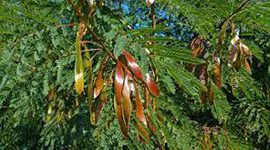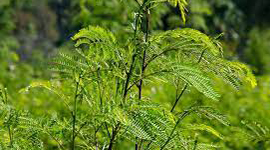Legumes Field Day focused on improving pasture and production

Pictured at the Legume Field Day are (from left): NQ Dry Tropics’ Senior Grazing Field Officer Joe O’Reagain, John Kersh, Nick Kempe from Agrimix, landholder, Laurie Reilly, Dr Ed Charmley from CSIRO, Chris Lambrides from Queensland Alliance for Agriculture and Food innovation, Bec Clapperton from DAF and Mel Matthews from CSIRO.
Desmanthus:
A woody-stemmed, spreading, fern-like perennial. Subtropical, summer-growing legume of Central American origin. Its main use is to provide high-quality stockfeed, as it is a strong competitor with summer grasses. The genus Desmanthus is a Mimosaceae legume containing some 24 species native to the Americas and range from being herbaceous to suffruticose in habit (woody and perennial at the base but remaining herbaceous above).
NQ Dry Tropics and the Department of Agriculture and Fisheries (DAF) hosted a field day at Alligator Creek where experts led discussions about legumes for improving livestock production.
Decades of research has gone into developing desmanthus pastures to increase livestock productivity across northern Australia.
Agrimix Pastures in conjunction with JCU has established a trial site at Alligator Creek, south of Townsville, where different varieties of the legume have been planted to see how they tolerate the tropical conditions.
Chris Gardiner, a JCU researcher, known as the father of desmanthus in Australia, is conducting evaluation trials with more than 140 varieties of different legumes and grasses. The trials are taking place at the Alligator Creek Agrimix Pastures Research Station.

The story of desmanthus in the north started in the 1970s when teams were sent abroad to collect seeds from plants from the Americas (North, Central and South). This work was led by CSIRO and Department of Agriculture (DAF), in a bid to collect desmanthus to see if it would be suitable for Queensland.
Trials were conducted in six areas around the state inducing Longreach, Blackall and Julia Creek. A whole range of legumes like stylo, forage peanuts and butterfly pea where planted, and after a decade, in same cases, two decades, the plants that flourished was desmanthus.
Mr Gardiner collected seeds from the survivors, to continue with selective trials. The legumes at the Alligator Creek site, dubbed cultivators JCU 1-9 are the most resilient relatives of those earliest varieties.
From there researchers teamed up with Agrimix to go through a plant breeding process to prove the plants are different to other varieties of desmanthus and they’re stable in terms of genetics.
The result has been the development of Progardes desmanthus, with trials showing the highly palatable source of protein delivers increased liveweight gain, increased posture productivity and in turn, increased profitability.
The long-term objective is to determine if desmanthus is an effective legume for improving livestock production in terms of increased liveweight gains, reproductive rates, and turn-off, particularly in the semi-arid clay soil regions of northern Australia, where few, if any, other herbaceous sown pasture legumes are currently adapted.
Widespread plantings by graziers will confirm whether this potential can be realised and what contribution the legume can make to sustainability of pastures in these regions.
NQ Dry Tropics’ Senior Grazing Field Officer Joe O’Reagain discussing the benefits of legumes in a grazing enterprise.
Mel Matthews, CSIRO.
Desmanthus in methane emissions project
Agrimix is leading a project to investigate if Desmanthus can help reduce methane emissions in cattle. Read more here:

Leucaena varieties Redlands and Wondergraze were also discussed
| Redlands | Wondergraze |
|---|---|
 |
 |
|
The Redlands variety is named after the Queensland Department of Agriculture and Fisheries (QDAF) research station where the University of Queensland variety development site is in Brisbane. Redlands is an inter-specific hybrid between Leucaena pallida and Leucaena Leucocephala subsp. Glabrata. Redlands was released in 2017 for commercial plantings with successful establishment trials undertaken in northern Queensland. On-farm trials investigating palatability and cattle weight gains are currently being conducted with interim results being consistent with weight gains generally achieved with leucaena. Redlands has a very high tolerance to psyllids, making it highly suitable for planting in coastal areas or other locations prone to high psyllid incidence. |
Wondergraze is an intraspecific hybrid and was released to the market in 2011. Wondergraze has early seedling vigour and some cold tolerance and is a bushier plant than the other leucaena cultivars, putting its growth into foliage and branches rather than woody stems, increasing its attractiveness for grazing and crop maintenance. |
ALSO IN THIS ISSUE:



